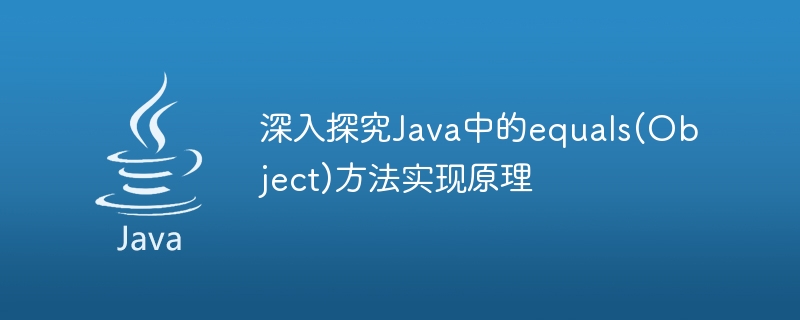Home >Java >javaTutorial >A deep dive into the internal implementation of the equals(Object) method in Java
A deep dive into the internal implementation of the equals(Object) method in Java
- 王林Original
- 2024-01-11 16:24:06887browse

In-depth exploration of the implementation principle of equals(Object) method in Java
Introduction:
In Java programming, the equals(Object) method is used to compare two One of the important methods to determine whether objects are equal. In actual development, we often use this method to compare whether two objects have the same content. However, many people lack an in-depth understanding of the implementation principles of the equals(Object) method. This article will deeply explore the principles of the equals(Object) method in Java and explain it in detail from three aspects: Java's inheritance system, default equals(Object) method implementation, and custom equals(Object) method implementation.
1. Java inheritance system:
In Java, all classes ultimately inherit from the Object class. The Object class defines a default equals(Object) method, whose method signature is: public boolean equals(Object obj). Therefore, every Java class will inherit the equals(Object) method, but different classes have different needs and requirements for the implementation of the equals(Object) method.
2. Default equals(Object) method implementation:
The default implementation of the equals(Object) method defined in the Object class uses the "==" operator to compare the references of two objects. same. This means that the default equals(Object) method compares the memory addresses of the two objects, not the contents of the objects. Such an implementation means that when we customize a class, if we do not override the equals(Object) method, the equals(Object) method will not be able to correctly compare whether the contents of two objects are equal, but will only compare whether their references are equal.
3. Implementation of the custom equals(Object) method:
In order to compare whether the contents of objects are equal in actual development, we usually need to customize the equals(Object) method. The custom equals(Object) method needs to follow the following principles:
- The input parameter is of type Object, which is used to receive any object.
- First compare the references of the two objects to see if they are equal, and return true if they are equal.
- Determine whether the input parameter object is null. If it is null, return false.
- Use the instanceof operator to determine whether two objects belong to the same class, and return false if not.
- Convert the input object to an instance of the current class, and then compare each attribute of the two objects one by one to see if they are equal.
It should be noted that when we customize a class, we must rewrite the equals(Object) method and hashCode() method at the same time to ensure the correctness of the equals(Object) method.
4. Some notes on the equals(Object) method:
- The equals(Object) method must follow the principles of reflexivity, symmetry, transitivity and consistency. That is, for any non-null reference value x, y, and z, if x.equals(y) returns true, then x.equals(z) must also return true; if x.equals(y) returns true, then y.equals( x) must also return true; if both x.equals(y) and y.equals(z) return true, x.equals(z) must also return true; for any non-null reference value x, x.equals(null ) must return false.
- The equals(Object) method must be able to handle the case of null values. When customizing the equals(Object) method, you need to first determine whether the input parameter is null.
- The equals(Object) method needs to use appropriate methods to compare when comparing the properties of objects. For example, use the equals() method to compare string type properties, and use the Arrays.equals() method to compare array type properties. Properties etc.
Summary:
Through in-depth exploration of the equals(Object) method in Java, we learned that the default equals(Object) method compares whether the references of objects are equal, rather than comparing the objects. Whether the contents are equal. In order to achieve content equality comparison, we need to customize the equals(Object) method and implement it according to certain principles. At the same time, in order to ensure the correctness of the equals(Object) method, we also need to rewrite the hashCode() method. Understanding the principle and implementation mechanism of the equals(Object) method will help us correctly determine whether two objects are equal and avoid unnecessary errors when writing code.
The above is the detailed content of A deep dive into the internal implementation of the equals(Object) method in Java. For more information, please follow other related articles on the PHP Chinese website!
Related articles
See more- The implementation principle and rewriting method of NEW in JS
- In-depth analysis of final implementation principles in Java (with examples)
- Analysis and introduction to the implementation principle of ThreadLocal (with code)
- RBAC permission control implementation principle - design of permission table, user table and association table
- What is the implementation principle of SpringBoot automatic configuration?

